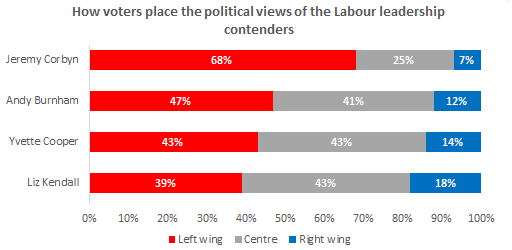The uphill battle for left wing Labour
The uphill battle for left wing Labour
Unless there was any doubt about how Jeremy Corbyn is perceived, voters clearly identify the new Labour leader as significantly to the left of all three of his rivals. Two thirds (68%) of all voters describes him as left wing, compared to around two in five that said the same about the other three leadership contenders.

The problem for Jeremy Corbyn is that he is also significantly to the left of the electorate. While they have no problem locating him on the left of the political spectrum, only a third (32%) of voters would place themselves there, with 40% describing themselves as in the centre.
When one directly compares how individual participants describe themselves and Jeremy Corbyn, more than half of voters were able to identify that he was to the left of them, with two in five saying significantly so. The fact that so early on a sizeable proportion consider him to have noticeably different political views to their own is a problem.
Can the voters be convinced?
But just because this is the case it does not necessarily mean the voters are entirely shut off, or that the priorities of the left are necessarily different to those in the centre.
Three quarters (73%) of all likely voters thought that the Labour Party should be focusing on protecting the NHS, while three fifths (59%) thought they should be demonstrating that they can be trusted with the economy. Interestingly, this is not too different to what left wing voters think as well (79% and 51% selected these respectively), so there is some overlap on the broad brushstrokes.
But what demonstrating their fitness to manage financial matters means to left wingers seems to be fighting against austerity (48%) and opposing benefit cuts (39%), which voters generally don?t (only 29% and 27% selected these respectively).
And then the thorny issue of immigration returns to haunt the party. Just over half (52%) of voters thought that Labour should concentrate on lowering immigration, but only 29% of left wingers agreed.
The demographic realities of modern Britain
These differences in priorities also leads us to look at the main electoral difficulty facing a Corbyn-lead Labour Party.
Voters identifying as left wing are focused in relatively small urban groups such as students (50%) and social housing tenants (51%), and are concentrated in relatively few constituencies.
Even Labour?s traditional wider base of support, the ?white working classes?, more or less evenly describe themselves as left wing and right wing (28% vs 24% respectively) and are not the dead certain Labour voters one might have expected in the past.
Exacerbating this problem, 42% of likely voters describe themselves as pensioners or the ‘home owning middle classes’. Both groups consider themselves to be more right wing than left wing and divided heavily in favour of the Conservatives at the last election.
It is these larger groups of voters that Jeremy Corbyn will have to win over, but at present they do not appear to be fertile ground for conversion to a traditional left wing program. At the very least Corbyn will have to concede something to the demographic reality that modern Britain has become older and more middle class than ever before.



